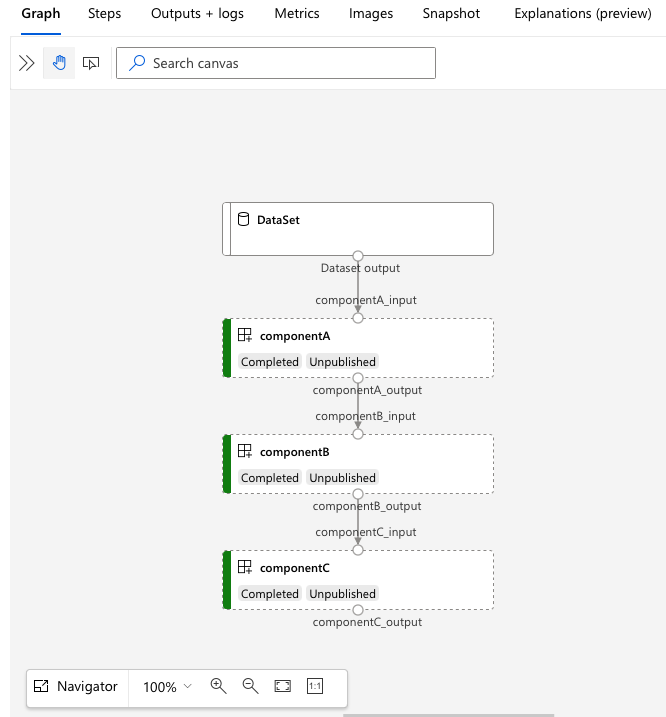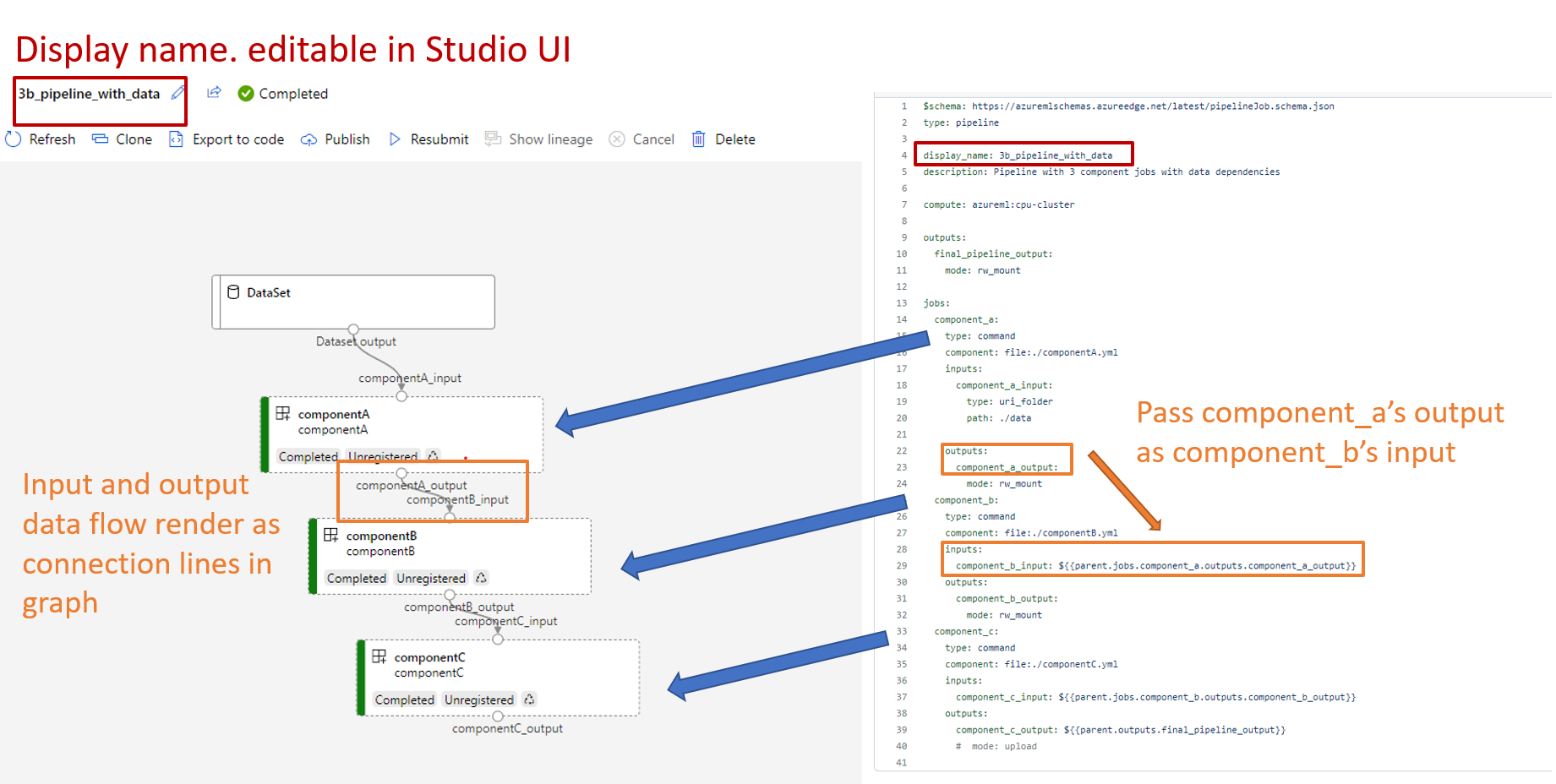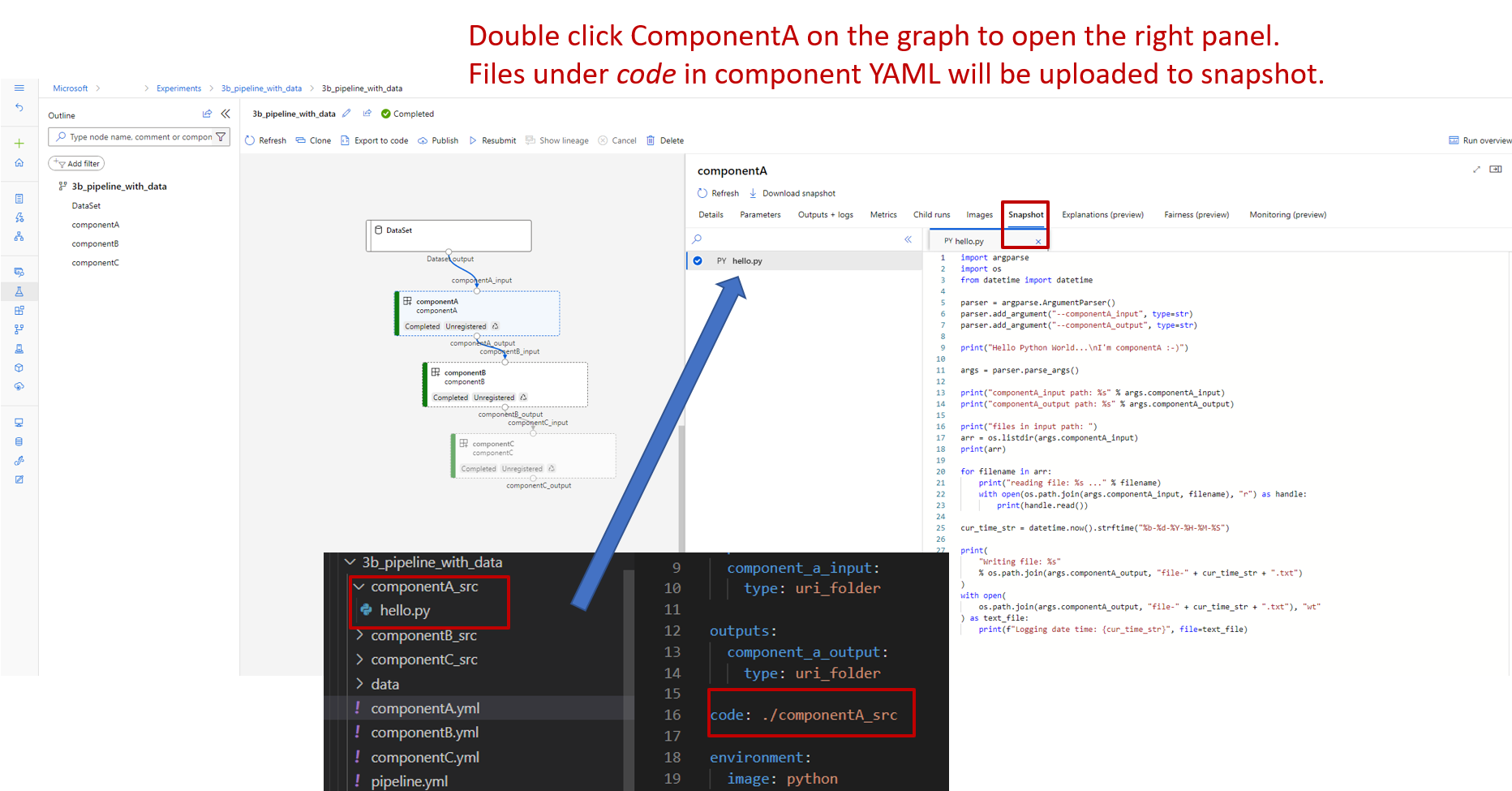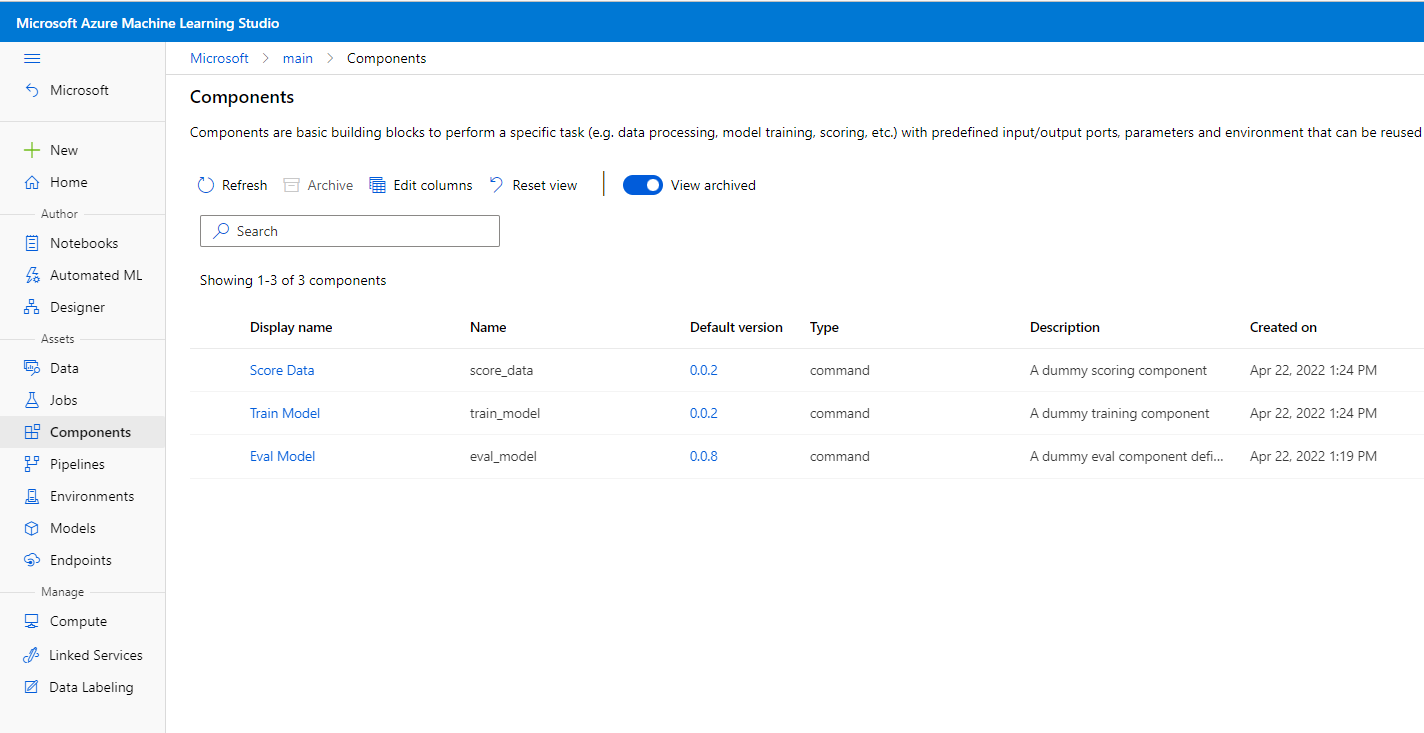Note
Access to this page requires authorization. You can try signing in or changing directories.
Access to this page requires authorization. You can try changing directories.
APPLIES TO:  Azure CLI ml extension v2 (current)
Azure CLI ml extension v2 (current)
In this article, you learn how to create and run machine learning pipelines by using Azure CLI and components. You can create pipelines without using components, but components provide flexibility and enable reuse. Azure Machine Learning pipelines can be defined in YAML and run from the CLI, authored in Python, or composed in the Azure Machine Learning studio Designer via a drag-and-drop UI. This article focuses on the CLI.
Prerequisites
An Azure subscription. If you don't have an Azure subscription, create a trial subscription before you begin. Try the trial subscription.
The Azure CLI extension for Machine Learning, installed and set up.
A clone of the examples repository. You can use these commands to clone the repo:
git clone https://github.com/Azure/azureml-examples --depth 1 cd azureml-examples/cli/jobs/pipelines-with-components/basics
Suggested prereading
Create your first pipeline with components
First, you'll create a pipeline with components by using an example. Doing so gives you an initial impression of what a pipeline and component look like in Azure Machine Learning.
In the cli/jobs/pipelines-with-components/basics directory of the azureml-examples repository, go to the 3b_pipeline_with_data subdirectory. There are three types of files in this directory. These are the files that you need to create when you build your own pipeline.
pipeline.yml. This YAML file defines the machine learning pipeline. It describes how to break a full machine learning task into a multistep workflow. For example, consider the simple machine learning task of using historical data to train a sales forecasting model. You might want to build a sequential workflow that contains data processing, model training, and model evaluation steps. Each step is a component that has a well-defined interface and can be developed, tested, and optimized independently. The pipeline YAML also defines how the child steps connect to other steps in the pipeline. For example, the model training step generates a model file and the model file is passed to a model evaluation step.
component.yml. These YAML files define the components. They contain the following information:
- Metadata: Name, display name, version, description, type, and so on. The metadata helps to describe and manage the component.
- Interface: Inputs and outputs. For example, a model training component takes training data and number of epochs as input and generates a trained model file as output. After the interface is defined, different teams can develop and test the component independently.
- Command, code, and environment: The command, code, and environment to run the component. The command is the shell command to run the component. The code usually refers to a source code directory. The environment can be an Azure Machine Learning environment (curated or customer created), Docker image, or conda environment.
component_src. These are the source code directories for specific components. They contain the source code that's run in the component. You can use your preferred language, including Python, R, and others. The code must be run by a shell command. The source code can take a few inputs from the shell command line to control how this step is run. For example, a training step might take training data, learning rate, and the number of epochs to control the training process. The argument of a shell command is used to pass inputs and outputs to the code.
You'll now create a pipeline by using the 3b_pipeline_with_data example. Each file is explained further in the following sections.
First, list your available compute resources by using the following command:
az ml compute list
If you don't have it, create a cluster called cpu-cluster by running this command:
Note
Skip this step to use serverless compute.
az ml compute create -n cpu-cluster --type amlcompute --min-instances 0 --max-instances 10
Now create a pipeline job that's defined in the pipeline.yml file by running the following command. The compute target is referenced in the pipeline.yml file as azureml:cpu-cluster. If your compute target uses a different name, remember to update it in the pipeline.yml file.
az ml job create --file pipeline.yml
You should receive a JSON dictionary with information about the pipeline job, including:
| Key | Description |
|---|---|
name |
The GUID-based name of the job. |
experiment_name |
The name under which jobs will be organized in studio. |
services.Studio.endpoint |
A URL for monitoring and reviewing the pipeline job. |
status |
The status of the job. It will probably be Preparing at this point. |
Go to the services.Studio.endpoint URL to see a visualization of the pipeline:

Understand the pipeline definition YAML
You'll now look at the pipeline definition in the 3b_pipeline_with_data/pipeline.yml file.
Note
To use serverless compute, replace default_compute: azureml:cpu-cluster with default_compute: azureml:serverless in this file.
$schema: https://azuremlschemas.azureedge.net/latest/pipelineJob.schema.json
type: pipeline
display_name: 3b_pipeline_with_data
description: Pipeline with 3 component jobs with data dependencies
settings:
default_compute: azureml:cpu-cluster
outputs:
final_pipeline_output:
mode: rw_mount
jobs:
component_a:
type: command
component: ./componentA.yml
inputs:
component_a_input:
type: uri_folder
path: ./data
outputs:
component_a_output:
mode: rw_mount
component_b:
type: command
component: ./componentB.yml
inputs:
component_b_input: ${{parent.jobs.component_a.outputs.component_a_output}}
outputs:
component_b_output:
mode: rw_mount
component_c:
type: command
component: ./componentC.yml
inputs:
component_c_input: ${{parent.jobs.component_b.outputs.component_b_output}}
outputs:
component_c_output: ${{parent.outputs.final_pipeline_output}}
# mode: upload
The following table describes the most commonly used fields of the pipeline YAML schema. To learn more, see the full pipeline YAML schema.
| Key | Description |
|---|---|
type |
Required. The job type. It must be pipeline for pipeline jobs. |
display_name |
The display name of the pipeline job in the studio UI. Editable in the studio UI. It doesn't have to be unique across all jobs in the workspace. |
jobs |
Required. A dictionary of the set of individual jobs to run as steps within the pipeline. These jobs are considered child jobs of the parent pipeline job. In the current release, supported job types in pipeline are command and sweep. |
inputs |
A dictionary of inputs to the pipeline job. The key is a name for the input within the context of the job, and the value is the input value. You can reference these pipeline inputs by the inputs of an individual step job in the pipeline by using the ${{ parent.inputs.<input_name> }} expression. |
outputs |
A dictionary of output configurations of the pipeline job. The key is a name for the output in the context of the job, and the value is the output configuration. You can reference these pipeline outputs by the outputs of an individual step job in the pipeline by using the ${{ parents.outputs.<output_name> }} expression. |
The 3b_pipeline_with_data example contains a three-step pipeline.
- The three steps are defined under
jobs. All three steps are of typecommand. Each step's definition is in a correspondingcomponent*.ymlfile. You can see the component YAML files in the 3b_pipeline_with_data directory.componentA.ymlis described in the next section. - This pipeline has data dependency, which is common in real-world pipelines. Component A takes data input from a local folder under
./data(lines 18-21) and passes its output to component B (line 29). Component A's output can be referenced as${{parent.jobs.component_a.outputs.component_a_output}}. default_computedefines the default compute for the pipeline. If a component underjobsdefines a different compute, component-specific settings are respected.
Read and write data in a pipeline
One common scenario is to read and write data in a pipeline. In Azure Machine Learning, you use the same schema to read and write data for all types of jobs (pipeline jobs, command jobs, and sweep jobs). Following are examples of using data in pipelines for common scenarios:
- Local data
- Web file with a public URL
- Azure Machine Learning datastore and path
- Azure Machine Learning data asset
Understand the component definition YAML
Here's the componentA.yml file, an example of YAML that defines a component:
$schema: https://azuremlschemas.azureedge.net/latest/commandComponent.schema.json
type: command
name: component_a
display_name: componentA
version: 1
inputs:
component_a_input:
type: uri_folder
outputs:
component_a_output:
type: uri_folder
code: ./componentA_src
environment:
image: python
command: >-
python hello.py --componentA_input ${{inputs.component_a_input}} --componentA_output ${{outputs.component_a_output}}
This table defines the most commonly used fields of component YAML. To learn more, see the full component YAML schema.
| Key | Description |
|---|---|
name |
Required. The name of the component. It must be unique across the Azure Machine Learning workspace. It must start with a lowercase letter. Lowercase letters, numbers, and underscores (_) are allowed. Maximum length is 255 characters. |
display_name |
The display name of the component in the studio UI. It doesn't have to be unique within the workspace. |
command |
Required. The command to run. |
code |
The local path to the source code directory to be uploaded and used for the component. |
environment |
Required. The environment that's used to run the component. |
inputs |
A dictionary of component inputs. The key is a name for the input within the context of the component, and the value is the component input definition. You can reference inputs in the command by using the ${{ inputs.<input_name> }} expression. |
outputs |
A dictionary of component outputs. The key is a name for the output within the context of the component, and the value is the component output definition. You can reference outputs in the command by using the ${{ outputs.<output_name> }} expression. |
is_deterministic |
Whether to reuse the previous job's result if the component inputs don't change. The default value is true. This setting is also known as reuse by default. The common scenario when set to false is to force reload data from cloud storage or a URL. |
In the example in 3b_pipeline_with_data/componentA.yml, component A has one data input and one data output, which can be connected to other steps in the parent pipeline. All the files in the code section in the component YAML will be uploaded to Azure Machine Learning when the pipeline job is submitted. In this example, files under ./componentA_src will be uploaded. (Line 16 in componentA.yml.) You can see the uploaded source code in the studio UI: double-click the componentA step in the graph and go to the Code tab, as shown in the following screenshot. You can see that it's a hello-world script doing some simple printing, and that it writes the current date and time to the componentA_output path. The component takes input and provides output via the command line. It's handled in hello.py via argparse.
Input and output
Input and output define the interface of a component. Input and output can be literal values (of type string, number, integer, or boolean) or an object that contains an input schema.
Object input (of type uri_file, uri_folder, mltable, mlflow_model, or custom_model) can connect to other steps in the parent pipeline job to pass data/models to other steps. In the pipeline graph, the object type input renders as a connection dot.
Literal value inputs (string, number, integer, boolean) are the parameters you can pass to the component at runtime. You can add a default value of literal inputs in the default field. For number and integer types, you can also add minimum and maximum values by using the min and max fields. If the input value is less than the minimum or more than the maximum, the pipeline fails at validation. Validation occurs before you submit a pipeline job, which can save time. Validation works for the CLI, the Python SDK, and the Designer UI. The following screenshot shows a validation example in the Designer UI. Similarly, you can define allowed values in enum fields.
If you want to add an input to a component, you need to make edits in three places:
- The
inputsfield in the component YAML. - The
commandfield in the component YAML. - In component source code to handle the command-line input.
These locations are marked with green boxes in the preceding screenshot.
To learn more about inputs and outputs, see Manage inputs and outputs for components and pipelines.
Environments
The environment is the environment in which the component runs. It could be an Azure Machine Learning environment (curated or custom registered), a Docker image, or a conda environment. See the following examples:
- Registered Azure Machine Learning environment asset. The environment is referenced in the component with
azureml:<environment-name>:<environment-version>syntax. - Public docker image.
- Conda file. The conda file needs to be used together with a base image.
Register a component for reuse and sharing
Although some components are specific to a particular pipeline, the real benefit of components comes from reuse and sharing. You can register a component in your Machine Learning workspace to make it available for reuse. Registered components support automatic versioning so you can update the component but ensure that pipelines that require an older version will continue to work.
In the azureml-examples repository, go to the cli/jobs/pipelines-with-components/basics/1b_e2e_registered_components directory.
To register a component, use the az ml component create command:
az ml component create --file train.yml
az ml component create --file score.yml
az ml component create --file eval.yml
After these commands run to completion, you can see the components in studio, under Assets > Components:
Select a component. You see detailed information for each version of the component.
The Details tab shows basic information like the component name, who created it, and the version. There are editable fields for Tags and Description. You can use tags to add search keywords. The description field supports Markdown formatting. You should use it to describe your component's functionality and basic use.
On the Jobs tab, you see the history of all jobs that use the component.
Use registered components in a pipeline job YAML file
You'll now use 1b_e2e_registered_components as an example of how to use registered component in pipeline YAML. Go to the 1b_e2e_registered_components directory and open the pipeline.yml file. The keys and values in the inputs and outputs fields are similar to those already discussed. The only significant difference is the value of the component field in the jobs.<job_name>.component entries. The component value is in the form azureml:<component_name>:<component_version>. The train-job definition, for example, specifies that the latest version of the registered component my_train should be used:
type: command
component: azureml:my_train@latest
inputs:
training_data:
type: uri_folder
path: ./data
max_epocs: ${{parent.inputs.pipeline_job_training_max_epocs}}
learning_rate: ${{parent.inputs.pipeline_job_training_learning_rate}}
learning_rate_schedule: ${{parent.inputs.pipeline_job_learning_rate_schedule}}
outputs:
model_output: ${{parent.outputs.pipeline_job_trained_model}}
services:
my_vscode:
Manage components
You can check component details and manage components by using CLI v2. Use az ml component -h to get detailed instructions on component commands. The following table lists all available commands. See more examples in Azure CLI reference.
| Command | Description |
|---|---|
az ml component create |
Create a component. |
az ml component list |
List the components in a workspace. |
az ml component show |
Show a component's details. |
az ml component update |
Update a component. Only a few fields (description, display_name) support update. |
az ml component archive |
Archive a component container. |
az ml component restore |
Restore an archived component. |
Next step
- Try the CLI v2 component example



